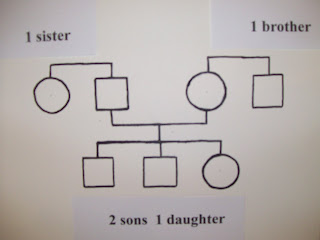
You should just about have it. A three to four generation family tree. Congratulations. Be sure and remember that for each square and circle you need to place near it the information regarding birth, death, place of birth, place of death, where buried, and all the other things you remember, or would want someone else to know about this person in your family tree. By now the first page in your notebook should look pretty messy. You have 79 sheets left, so you can redraw the geneogram more to your liking.
Now before you go on in your tree climbing, be sure and record what you know about your family now. You may be the only one to do so. Keep up the good work.
The above picture is a geneogram I have been working on. It is rough, but ready to show you a three generation family tree. When you have completed your three generational family tree, you are ready to begin, ge-ne-al-o-gy 201.


